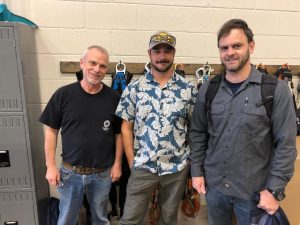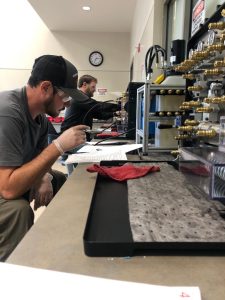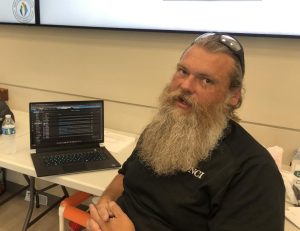It appears that the U.S. Bureau of Labor Statistics is blown away by the rapid growth of the wind energy field.

The Bureau lists cites the job outlook for Wind Turbine Technicians through 2031 as a “much faster than average” 44% growth rate, with an estimated 4,900 additional jobs to come. It lists 2021 median pay for as $56,260.
John Hall of Vermont, Aaron Waechter of New Hampshire and Jonah Hudson of Georgia are scheduled to be deployed in mid-September to work on North America’s first full-scale commercial offshore wind project at Martha’s Vineyard, and they took their Basic Technical Training class and certifications at New College Institute Aug. 28 through Sept. 1.
They will work on the construction and installation of wind turbines at Vineyard Wind, the nation’s first utility-scale offshore wind energy project, over 15 miles off the coast of Massachusetts. The 62 turbines will produce 800 MW, enough to power 400,000 homes and businesses, according to www.vineyardwind.com.
Vineyard Wind will be the nation’s second offshore wind farm. The first is Block Island, with five turbines put in operation in 2016, according to us.orsted.com.
The next major offshore wind energy project is Dominion’s Coastal Virginia Offshore Wind (CVOW), off the shore of Virginia Beach. It has two working prototype wind turbines now, and manufacture is beginning on the 176 wind turbines that will generate 2.6 gigawatts of energy, according to coastalvawind.com.

Several other wind farms along the East Coast are in the planning stages.
The development of offshore wind energy in the United States “is going to be a big 10 to 15 years’ worth of work,” Hudson said. “I’m trying to get on beginning of it— get all the training — get ready for more and more jobs. The more training you have, the more valuable you are.”
He said the map of planned wind energy projects shows them along the East Coast “going all the way down to Georgia. For the next 10 years we can keep on rolling.”
The U.S. Wind Turbine Database at eerscmap.usgs.gov lists 72,731 turbines in the nation. Only those seven of Block Island and CVOW are offshore — so far.
All three men work in the energy field, but Hall is the only one who has worked on wind turbines before. In 2005-06 he helped put up 400 towers in upstate New York by the Canadian border.
Working off and living on a ship
At Vineyard Winds, Hall and Hudson will be paired as a work team, Hall said.
The three already are employed by Global Wind Services, which is paying for their training and accommodations. Waechter will work on a ship, and Hall and Hudson will work on land doing prewiring of the structures. The duo also will fill in offshore as needed.
“We’ll be the relief pitchers,” joked Hall. “Ground support.”
Multiple contractors will work on different aspects of the turbines, Hudson said.
Those who build the turbines in the ocean will be based on a ship. A helicopter will bring them to the ship, where they will live for those three weeks at a time, working in 12-hour shifts.
In Virginia, “offshore wind turbine technicians supporting CVOW will live on a Service Operations Vessel – two weeks on, two weeks off,” wrote Jeremy Slayton, spokesperson for Dominion Energy, by email.
“That’s typical of the type of work that I do,” Waechter said.
Energy Workers

Wind energy “is growing fast,” Hudson said. “They’re hiring people. … There are a lot of these projects going in. It seems to be a lot of opportunity,” and pay is good.
Hudson is from Metter, Georgia, near Savannah —“Everything’s better in Metter,” he quipped. He will fly back to Georgia during each of his three weeks off work.
“The time off, three weeks, is what got me interested,” he said.
Plus, “there aren’t a lot of high-paying jobs in the South.” The choice is to “be gone and make a lot of money for your family, or stay home and not so much.”
This deployment will be his first time working on wind energy, though he’s no stranger to clean energy — he has worked in solar before.
Not only is the installation and use of wind turbines important, but also the construction, Hudson said: “We’re hoping to keep the work here. Previous projects were all built by Norwegians.”
Training
NCI’s classes are certified by the Global Wind Organisation (GWO), a non-profit body founded and owned by globally leading wind turbine manufacturers and owners/operators to set industry-wide safety standards.
Hudson said the trio has done their basic GWO training, Sea Survival, Basic Safety Training and Advanced Rescue Training, and now are in the Basic Technician Training. Next, they’ll have to work on some online modules and “some stuff through G.E. Other than that, everything else is done.” They started their training at the beginning of August.
During a Thursday class at NCI the students worked on a hydraulics model. Hall explained: Fluid gets pumped through a controller to work a motor at the end of the line. “The fluid does the heavy work,” he said. “It saves our back. What the human body cannot do the hydraulic can.”
Waetcher said before the BTT training at NCI, the trio took training at in institution in Texas. The Texas classes were held outdoors, and the weather was hot and miserable 110 degrees. They were appreciative of the comfort of NCI’s indoor, air-conditioned class environment.
Hudson added about the equipment in NCI’s High Bay area: “The stuff you have back here is world class. World class top-of-the-line equipment. You guys are stacked. There’s a lot more tools I’d love to have more time to play with.”



